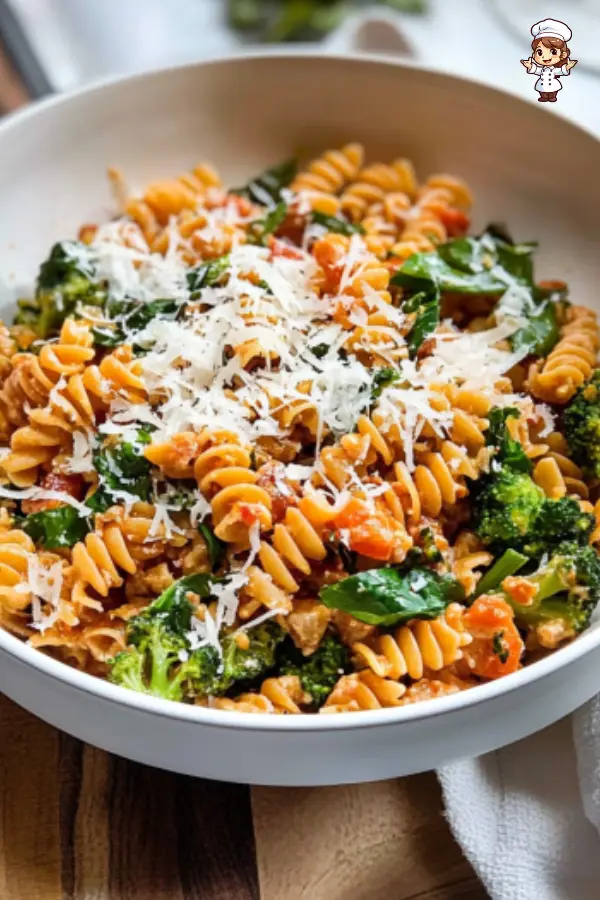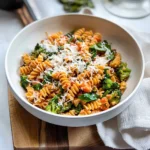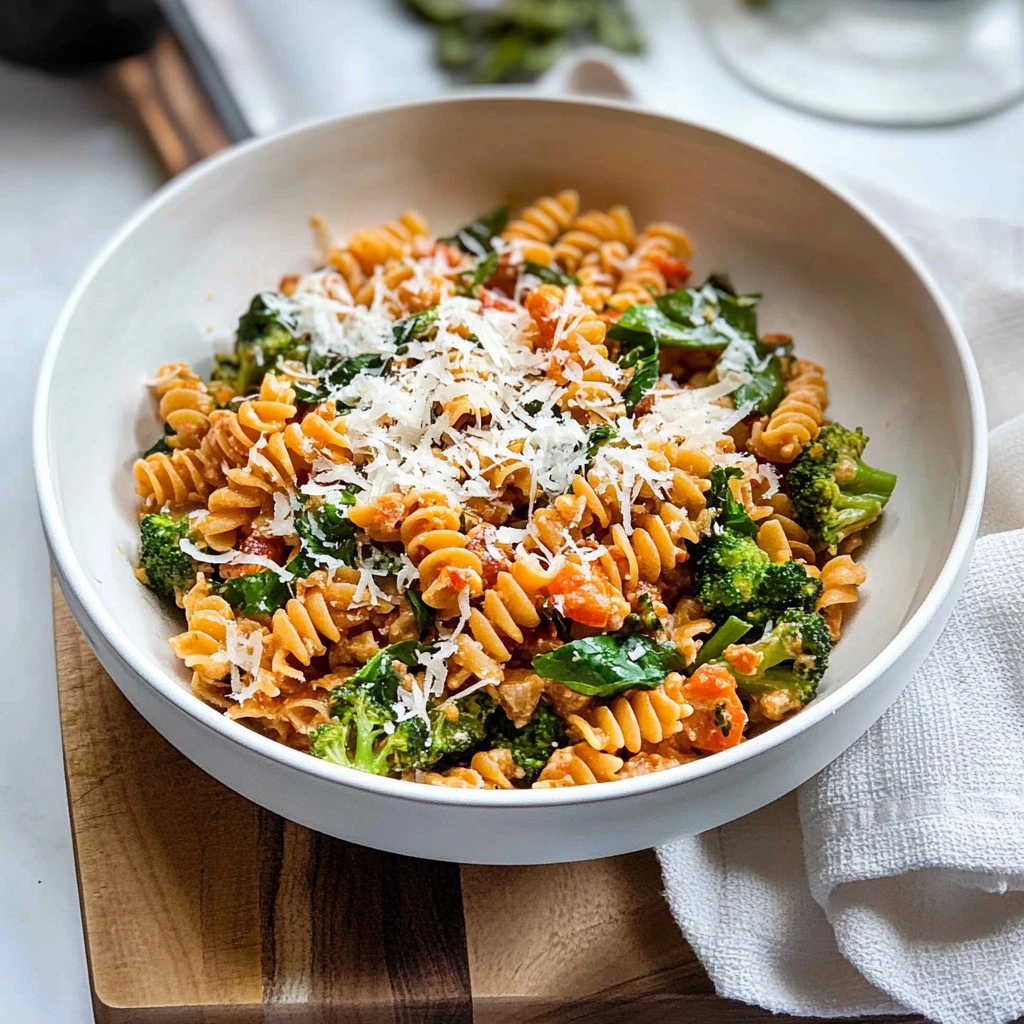Vegetable pasta is a delightful dish that combines the heartiness of pasta with a colorful array of vegetables. It’s a fantastic way to bring a burst of flavors and nutrients to your table. Whether you’re looking for a quick weeknight dinner or a meal for a special occasion, this dish can be both visually appealing and satisfying. The use of seasonal vegetables allows for a fresh taste, and you can easily customize it to your preference. Prepare to experience a culinary journey that highlights the beauty of vegetables in every bite!
Ingredients for Vegetable Pasta
List of ingredients with measurements
- 8 ounces of pasta (spaghetti, penne, or your choice)
- 1 tablespoon olive oil
- 2 garlic cloves, minced
- 1 small onion, diced
- 1 bell pepper (any color), sliced
- 1 zucchini, sliced
- 1 cup cherry tomatoes, halved
- 1 cup spinach leaves
- 1 teaspoon Italian seasoning
- Salt and pepper to taste
- Grated Parmesan cheese for serving (optional)
Optional ingredient substitutions
- Pasta: Use whole wheat or gluten-free pasta for a healthier option.
- Olive oil: Coconut oil or avocado oil can be used instead.
- Veggies: Substitute any seasonal vegetables such as asparagus, broccoli, or mushrooms.
- Cheese: Nutritional yeast can be used as a vegan alternative to Parmesan cheese.
How to Make Vegetable Pasta Directions

Step 1: Boil the Pasta
Begin by bringing a large pot of salted water to a boil. Add the pasta of your choice and cook according to the package instructions until al dente. Stir occasionally to prevent sticking. Once cooked, reserve about half a cup of the pasta water, then drain the pasta in a colander and set it aside.
Step 2: Sauté the Aromatics
In the same pot, heat the olive oil over medium heat. Add the minced garlic and diced onion. Sauté for about 2-3 minutes until fragrant and the onion is translucent. This step adds a wonderful aromatic base for your vegetable pasta.
Step 3: Add the Vegetables
Next, add the sliced bell pepper and zucchini to the pot. Stir them in and cook for about 4-5 minutes until they begin to soften. Then, add the halved cherry tomatoes and spinach leaves, continuing to cook until the tomatoes are slightly wilted and the spinach has cooked down, about another 3 minutes.
Step 4: Combine with Pasta
Once the vegetables are cooked, add the drained pasta back to the pot. Sprinkle in the Italian seasoning, salt, and pepper to taste. If the pasta seems dry, gradually add the reserved pasta water until you reach your desired consistency. Stir everything together gently over low heat for another 2 minutes, allowing the flavors to meld.
Step 5: Serve
Remove the vegetable pasta from heat and consider garnishing with freshly grated Parmesan if desired. Serve it hot and enjoy your colorful, nutritious meal!
How to Serve Vegetable Pasta
Best ways to serve Vegetable Pasta
Vegetable pasta can be served in various attractive ways. Present it in a large bowl, allowing diners to help themselves, or plated individually for a more formal occasion. You can drizzle a little extra olive oil or a splash of lemon juice for added flavor before serving.
Serving suggestions or pairings
For a complete meal, pair vegetable pasta with a light salad, such as a simple arugula salad with lemon vinaigrette. Garlic bread or a crusty baguette complements the dish beautifully as well. If you’re looking for protein, consider adding grilled chicken or shrimp on top of the pasta. For a vegetarian option, toss in some chickpeas or cannellini beans to elevate the dish further.
How to Store Vegetable Pasta
Proper storage methods
To store leftover vegetable pasta, allow it to cool completely before placing it in an airtight container. It can be kept in the refrigerator for up to 3-4 days. If the pasta seems a bit dry the next day, you can add a splash of water or olive oil when reheating.
Tips for reheating or freezing
To reheat, place the pasta in a skillet over medium heat and stir gently until warmed through. You may want to add a little extra olive oil to help restore moisture. For long-term storage, vegetable pasta can be frozen. Place it in a freezer-safe container or zip-top bag and store it for up to 2 months. When ready to eat, thaw in the refrigerator overnight and reheat as desired.
Tips to Make Vegetable Pasta
Common mistakes to avoid
One common mistake is overcooking the pasta. Always cook it al dente, as it will continue to cook slightly when mixed with the hot vegetables. Another issue is using too many vegetables, which can lead to a dish that is too watery. It’s essential to find a balance. Also, don’t skip the seasoning! Properly seasoning at each step enhances the overall flavor.
Helpful tips for better results
To elevate your vegetable pasta, consider adding a touch of fresh herbs, like basil or parsley, just before serving. Toasting the garlic in the oil until it’s lightly golden can also enhance the flavor. Try to use a variety of colorful vegetables for visual appeal. Freshly cracked black pepper adds a nice finish, and don’t shy away from experimenting with different spices like red pepper flakes for a bit of heat.
Variation of Vegetable Pasta
Suggested variations or twists on the recipe
Vegetable pasta can be easily adapted based on your preferences. For an Asian twist, add soy sauce and stir-fried vegetables such as bok choy, bell pepper, and carrots, topping it with sesame seeds. Alternatively, you can create a creamy version by incorporating a cashew cream or Alfredo sauce made from cauliflower.
Adjustments for dietary preferences
To make a vegan version, simply omit any cheese or dairy and rely on plant-based ingredients. If you prefer a low-carb or keto option, consider swapping traditional pasta with zucchini noodles (zoodles) or spaghetti squash as a base. You can also make the dish gluten-free by using gluten-free pasta varieties available on the market.
FAQs
What can I do if the dish isn’t turning out right?
If your vegetable pasta doesn’t seem to come together as desired, check the seasoning. Sometimes, dishes may need a little extra salt, pepper, or acid (like lemon juice) to enhance the flavors. If it feels too dry, gradually add reserved pasta water or olive oil to achieve your preferred consistency.
Can I make this ahead of time?
Yes, vegetable pasta can be made ahead and stored in the refrigerator for 3-4 days. Just remember that some vegetables will lose their crispness when reheated. If you’re preparing for an event, consider cooking the pasta and vegetables separately and combining them just before serving to maintain texture.
What can I substitute for ingredients?
You can easily substitute many of the ingredients based on taste, availability, and dietary restrictions. For instance, swap versatile vegetables like zucchini for bell peppers or try whole grain pasta for a healthier choice. If you don’t have Italian seasoning, you can use individual herbs like oregano, thyme, and rosemary for a similar flavor profile.
Vegetable pasta is indeed a versatile and hearty meal, providing a delightful way to enjoy healthy vegetables. With its ease of preparation and rich flavors, it’s a dish everyone can appreciate and customize to their liking. Enjoy exploring the many options and variations this dish can offer, making it a staple in your kitchen!
Print
Vegetable Pasta
- Prep Time: 10 minutes
- Cook Time: 20 minutes
- Total Time: 30 minutes
- Yield: 4 servings 1x
- Category: Main Course
- Method: Stovetop
- Cuisine: Italian
Description
Vegetable pasta is a hearty dish combining pasta with colorful, nutritious vegetables. A customizable and satisfying meal for any occasion.
Ingredients
- 8 ounces of pasta (spaghetti, penne, or your choice)
- 1 tablespoon olive oil
- 2 garlic cloves, minced
- 1 small onion, diced
- 1 bell pepper (any color), sliced
- 1 zucchini, sliced
- 1 cup cherry tomatoes, halved
- 1 cup spinach leaves
- 1 teaspoon Italian seasoning
- Salt and pepper to taste
- Grated Parmesan cheese for serving (optional)
Instructions
- Cook pasta according to package instructions until al dente. Drain and set aside, reserving 1/2 cup pasta water.
- Heat olive oil in a pot. Add garlic and onion, sauté until fragrant and translucent (2-3 minutes).
- Add bell pepper and zucchini. Cook for 4-5 minutes. Add tomatoes and spinach, cooking for 3 more minutes until wilted.
- Add pasta to the vegetables and mix in Italian seasoning, salt, and pepper. Gradually add pasta water to adjust consistency. Stir gently over low heat for 2 minutes.
- Serve the pasta with optional grated Parmesan cheese and enjoy your colorful, nutritious meal!
Notes
- Substitute with whole wheat or gluten-free pasta for a healthier version.
- If dairy-free, use nutritional yeast instead of Parmesan.
- Season at every step to enhance flavors, especially adding salt after each major addition.
Nutrition
- Serving Size: 1 plate
- Calories: 300
- Sugar: 6g
- Sodium: 220mg
- Fat: 9g
- Saturated Fat: 1g
- Unsaturated Fat: 7g
- Trans Fat: 0g
- Carbohydrates: 45g
- Fiber: 7g
- Protein: 9g
- Cholesterol: 5mg
Keywords: vegetable pasta, pasta with vegetables, healthy pasta recipe, easy vegetable pasta, colorful pasta dish, vegan pasta

